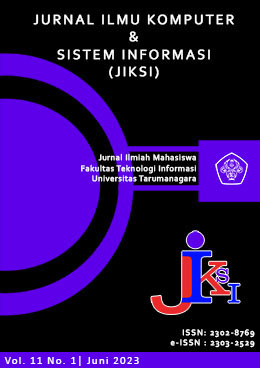Aplikasi Analisis Sentimen Komentar Pengguna Genshin Impact Di Play Store
Main Article Content
Abstract
Google Play functions as the official app store for the Android operating system, allowing users to browse and discover applications developed with the Android software development kit (SDK) and published through Google. Google Play also serves as a digital media store, offering music programs, books, movies, and television shows. It previously offered Google hardware for purchase until it introduced a separate online hardware store, Google Store, on March 11, 2015.The research will utilize a web-based application development tool that uses Flask and JavaScript as the application interface, and the Pandas library from Python for data manipulation. Naïve Bayes will be employed as the methodology for analyzing sentiments based on words, and K-Fold Cross Validation will be used to strengthen the accuracy of the analysis results.Sentiment analysis typically classifies opinions into three categories: positive and negative. However, applications that can perform the process of creating training and testing sets from consumer opinion data, simultaneously analyzing consumer sentiment and dynamically measuring the accuracy of the analysis results, are still scarce. This study aims to develop an application capable of analyzing consumer sentiment with the mentioned functionalities, wherein Naive Bayes is used as the classification method.
Article Details

This work is licensed under a Creative Commons Attribution-NonCommercial-ShareAlike 4.0 International License.
This work is licensed under a Jurnal Komunikasi Creative Commons Attribution-ShareAlike 4.0 International License.
References
Keller, Kevin L., & Donald R. Lehmann. (2006). “Brands and Branding: Research Findings and Future Priorities. Marketing Science. Vol. 25, No 6”. Maryland: INFORMS.
Buntoro, Ghulam Asrofi, Teguh Bharata Adji, & Adhistya Erna Purnamasari. (2016). Sentiment Analysis Candidates of Indonesian Presiden 2014 with Five Class Attribute. International Journal of Computer Applications. Vol. 136 No. 2. Ronowijayan :Universitas Muhammadiyah Ponorogo.
Natalius, Samuel. (2010). Metode Naive Bayes Classifier dan Penggunaannya pada Klasifikasi Dokumen. Bandung: Institut Teknologi Bandung
Sipayung, Evasaria M., Herastia Maharani, dan Ivan Zefanya. (2016). “Perancangan Sistem Analisis Sentimen Komentar Pelanggan Menggunakan Metode Naive Bayes Classifier”. Jurnal Sistem Informasi (JSI), VOL. 8, NO. 2. Bandung: Institut Teknologi Harapan Bangsa
Suhaimin, M.S., Hijazi, M.H., Rayner, Alfred, Bhat, S.M., Lestari, A.R., Pandey, A.C., Rajpoot, D.S., & Saraswa, M. (2019). informasi, menyampaikan pendapat atau pandangan terhadap sesuatu dan mengekspresikan opini, pengalaman maupun hal lain yang menjadi trend perhatian pada masyarakat. Hal tersebut sering disebut dengan sentimen. Analisis sentimen merupakan suatu proses yang digunakan untuk menentukan opini, emosi dan.
Marlinda, L., & Rianto, H. (2013). Pembelajaran Bahasa Indonesia Berbasis Web Menggunakan Metode Maximum Marginal Relevance. SESINDO 2013, 2013..
Madyatmadja, E.D., Yahya, B.N., & Wijaya, C. (2022). Contextual Text Analytics Framework for Citizen Report Classification: A Case Study Using the Indonesian Language. IEEE Access, 10, 31432-31444.
Muzakki, M. A. (2020). Klasifikasi dan Analisa Sentimen Kuesioner Fasilitas dan Layanan untuk Universitas Qomaruddin Gresik. Journal of Computer Science and Visual Communication Design, 5(2), 68-76.
Setiabudi, R., Iswari, N.M., & Rusli, A. (2021). Enhancing text classification performance by preprocessing misspelled words in Indonesian language. TELKOMNIKA Telecommunication Computing Electronics and Control, 19.
Szafron, D., Greiner, R., Lu, P., Wishart, D.S., Macdonell, C., Anvik, J., Poulin, B., Lu, Z., & Eisner, R. (2003). Explaining Naive Bayes Classifications.
singh, K. (2020). A Pragmatic Study on Naive Bayes Classifier.
Zhang, H. (2004). The Optimality of Naive Bayes. The Florida AI Research Society.
Zhang, X., & Liu, C. (2022). Model Averaging Prediction by K-Fold Cross-Validation. SSRN Electronic Journal.
Hastie, T., Tibshirani, R., Friedman, J. H., & Friedman, J. H. (2009). The elements of statistical learning: data mining, inference, and prediction (Vol. 2, pp. 1-758). New York: springer.



